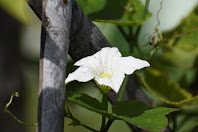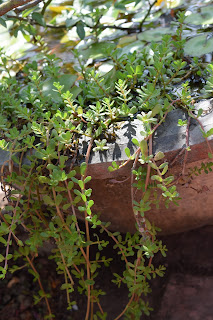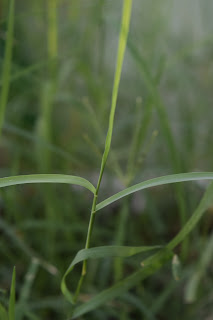Be it a garden on your terrace, balcony or land space, you can create an environment that can be a habitat for birds, bees, butterflies and birds.
Any place that breathes fresh can hold life, and therefore, read on only if you are an organic gardener or plan to be one.
In a previous post I mentioned the importance of water bodies in a garden.
A wholesome garden will have flowers for nectar for bees, butterflies, and other insects, fruits for bigger beings like squirrels, and fruit droppings will be consumed by insects. These insects will be kept in check by reptiles like gecko, garden lizard and spiders. These geckos and spiders may, in turn, fall prey to the visiting birds. Smaller birds will become meal for bigger birds like raptors - Shikra among others.
 |
| A Shikra waiting quietly to prey upon sunbirds in our terrace garden one evening |
A complete cycle can be created in your garden and they all will live parallelly with your plants, trees and the water bodies.
 |
| Butterflies are sign of a healthy green space |
Some pointers for a healthy garden besides having what you intend to grow in your garden, be it a flower garden, fruit garden or vegetable garden.
1. Reuse whatever possible from home to use as containers. Not only will you be able to declutter, but also reuse and upcycle with creative ideas. Smaller containers can hold plants that are not so needy, like succulents.
2. Make sure that all containers have holes in them. (A post on Container Preparation will soon be published).
3. Have a combination of plants that have varying stem strength, from soft stemmed grass to woody stemmed trees.
4. Also have a combination of plants that grow to varying heights, from ground level grass to tall (as much as you can manage) trees. Keep these plants such that all tall trees are not cluttered close to each other and they do not have to fight for Sunlight or space to branch out.
5. Different plants have different needs. Some need shade, some semi-shade, some full Sun, Arrange them so as to cater to their needs.
6. Have a combination of flowers and herbs also. Some flowers are better at attracting butterflies. Like this butterfly weed or the Milkweed.
7. Having made sure that you have a garden that is thriving or doing justice to the space occupied, let us keep one patch for the birds. Birds will come to a garden for one of is needs, water to drink, food, or water for bath.
8. From your neighborhood, find out what you can attract birds with. Most often small birds need water for bath, if you have sufficient trees around your house, as trees will give them food and protection from predators. If it is an apartment, it'll offer none of their needs. So you may have to provide all. That is water and food.
 |
| A green bee-eater with a fly-catch |
9. Have sufficient variety in flowering plants, esp. Ixora and hibiscus are very liked by bees and other pollinators. Once pollinator insects are there, birds will automatically follow.
10. With one or more water bodies in place and garden that offers food for the birds, and a habitat that can support a variety of birds that would either swing on grass blades or need stronger stem for support, next would be to identify one part of the garden from where birds can enter your garden, from some trees in the neighbourhood. So birds can jump off back to the trees when they sense danger.
11. At such a place, as in point 10, make an arch by bending some plant over, along the waterbody, so that the branches growing out of the arch can act as swinging sites for birds where they enter your garden, bathe, eat, play in the water in your garden
Now wouldn't that be a sight to behold!!!










































